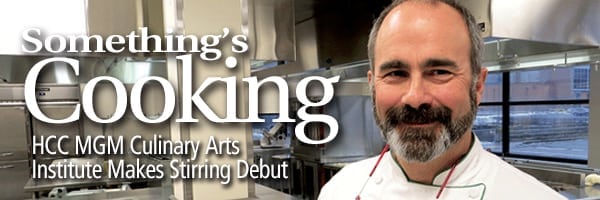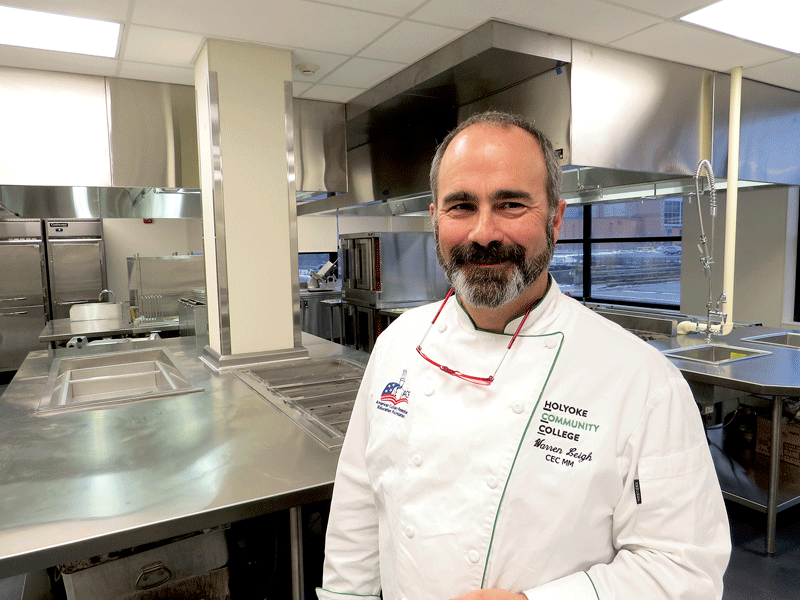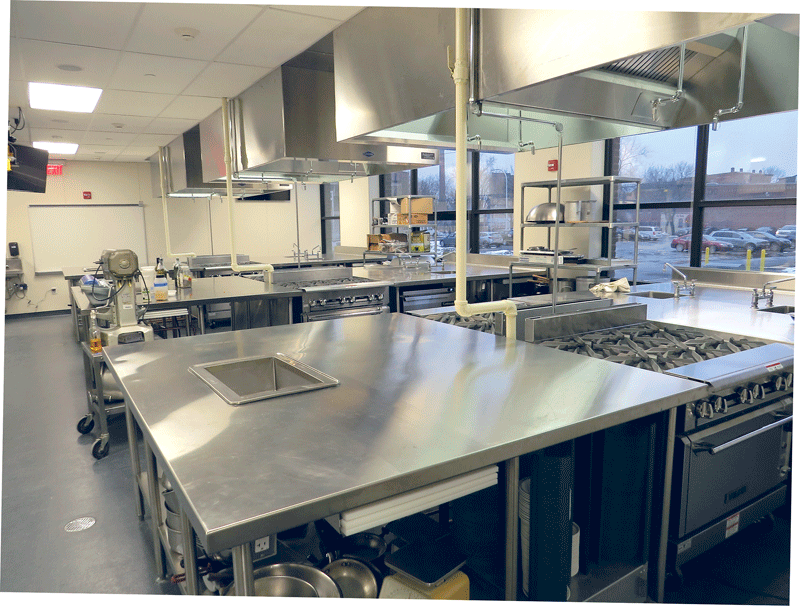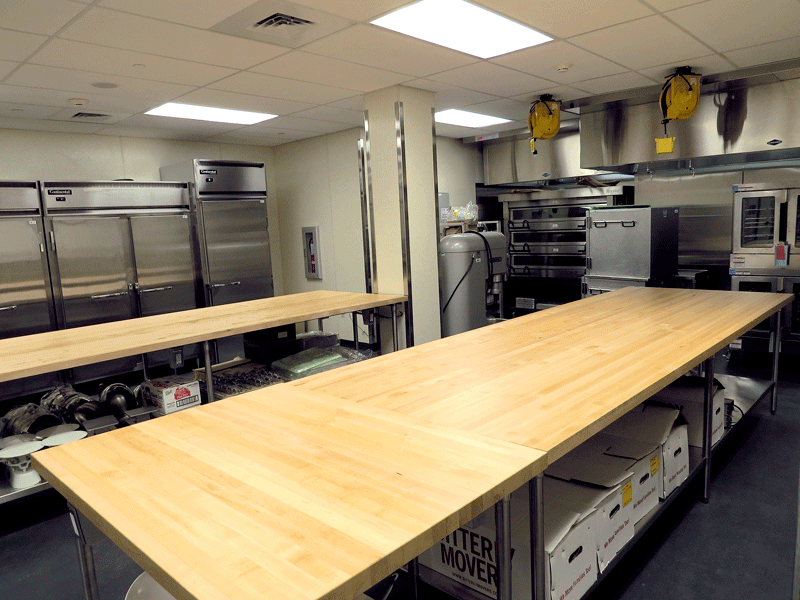
HCC MGM Culinary Arts Institute Makes Stirring Debut
Something’s Cooking

Chef Warren Leigh in one of the teaching kitchens at the new Holyoke Community College MGM Culinary Arts Institute.
The Holyoke Community College MGM Culinary Arts Institute opened its doors to considerable fanfare last month. Officials at the school wore out the phrase ‘state-of-the-art’ as they talked about its five kitchens and other facilities. But that’s only part of the story. The institute is also a key ingredient, as they say in culinary arts, in workforce-development initiatives, as well as efforts to revitalize
downtown Holyoke.
Chef Warren Leigh knew something was up when students arrived for the first class of the semester more than an hour early.
More to the point, he knew exactly what was up, and he didn’t blame those early birds one bit.
Indeed, it seems that people can’t wait to get a look at the $7.5 million Holyoke Community College MGM Culinary Arts Institute, now occupying the first two floors of the building in downtown Holyoke with a name that matches its shape: the Cubit. And that includes the students in Leigh’s classes, specifically the ones a semester or two into their studies within the culinary and hospitality programs who kept hearing about what was being built to replace the aging, insufficient facilities on the HCC campus. And hearing about them. And hearing about them.
So it’s no wonder they altered their schedules and gave themselves what amounted to — wait for it — a cook’s tour. Well, not really. Instead, it was an involved, quite lengthy tour, again for good reasons, as we’ll see when Leigh takes BusinessWest around in a little bit.
Several years in the making, the new, 20,000-square-foot, state-of-the-art facility boasts five kitchens, a separate bakery, an 80-seat dining facility that will host a variety of events, ultra-modern classrooms, a well-appointed student lounge, an area to change clothes, and much more.
“Aside from Johnson & Wales and the Culinary Institute of America, this is the most current, purpose-built culinary-arts facility in New England, maybe in the Northeast,” said Leigh, chair of the Hospitality Management and Culinary Arts programs at HCC. “It’s truly a regional resource.”
Beyond all that, and those points are noteworthy to be sure, the new center is a significant development, in every sense of that phrase, in many other respects.
First, it represents a huge step forward in the broad realm of workforce development within the culinary-arts field, both locally and regionally, a segment of the economy that was already growing and will now get a huge boost with the arrival in about eight months of MGM Springfield and a host of new restaurants.
The need to hire what will likely be several hundred food-service-related personnel is a big reason why MGM contributed $500,000 to this project and now has its name on the facility.

‘State-of-the-art’ is a phrase that defines all aspects of the new facility in the Cubit Building in downtown Holyoke.
But, overall, the food-service and hospitality sectors in Western Mass. are growing, and, as is the case in many fields, finding sufficient numbers of qualified help is becoming an ever-greater challenge.
The Culinary Arts Institute will help close the gap, said Michele Cabral, HCC’s interim dean for Business and Technology, who told BusinessWest that, like other initiatives undertaken at HCC in recent years, the institute is a direct response to recognized needs within the business community and a desire to meet them.
Meanwhile, the institute is both the cornerstone of efforts to renovate the Cubit Building into a mixed-use facility, with apartments on the upper floors, and one of the key ingredients (that’s an industry phrase) in efforts to bring people, businesses, and vibrancy to a surging downtown Holyoke.
For this issue, BusinessWest takes a tour of, and an in-depth look at, the Culinary Arts Institute to fully explain its significance to the college, the students who will learn there, and the region as a whole.
Food for Thought
Leigh wears a number of hats in his role as chair of hospitality management and culinary arts, including the traditional chef’s hat.
He’s added another one, but only figuratively.
Indeed, he doesn’t wear any headgear when he’s giving tours, which has become a big part of his job description these days. He’s led walkthroughs taken by constituencies ranging from elected officials to prospective students to media members, and there are many more already on the calendar.
He doesn’t mind this intrusion on his schedule, though, because, like all those at HCC, he’s quite proud of all the hard work that went into designing and building this facility — and obviously with the final product itself.
Before getting one of those tours, BusinessWest first wanted to talk about what brought everyone to this moment.
There has a been a culinary-arts program, in one form or another, at HCC for roughly 30 years, said Leigh, whose tenure covers roughly a third that period. The program, which years ago was more hospitality-related than culinary-focused, has had several homes over the years, none of them large or particularly well-equipped. The most recent was in the Frost Building in what he believes was the old music room.
The need for a larger, better facility was apparent, he went on, but so were the challenges to securing one, including a location and, especially, the funding. Finally, a plan was conceptualized that would make the college — and MGM — partners in the bold plans to revitalize the Cubit Building, which had been underutilized for many years.
This is a true public-private partnership, one that involves the college (and thus the state), the city of Holyoke, the federal government (specifically the U.S. Department of Commerce Economic Development Administration), MGM, and brothers Denis and Marco Luzuriaga, who purchased the Cubit Building and have invested heavily in its redevelopment.
As the partners in the ambitious initiative came together and plans started to materialize, those involved came to understand what this opportunity meant, and how they needed to take full advantage of it.
“A cross-functional team was put together, and it was told that, if we have the space, we have one chance to get this right — let’s talk about how to build what we actually want,” said Cabral. “Faculty, hospitality, and culinary were part of the team from day one in designing the space and selecting the equipment.”
They certainly did get it right, and the resulting facility enables HCC to greatly expand capacity and thus better serve the region and its culinary- and hospitality-related businesses.

Warren Leigh and Michele Cabral have devoted considerable time recently to the leading tours of the new Culinary Arts Institute, and there are many more scheduled.
Cabral qualified and quantified what it all means.
“This gives us the capacity to teach multiple sections of our credit programs,” she explained, “while at the same time responding to the needs of the community and teaching workforce development, professional development, and adult basic education related to culinary hospitality. In our old space, we only had one and a half kitchens, so we could only do one thing at a time.”
Leigh agreed, and noted that the institute is a “purpose-built facility” and one of the few in the region, if not the country, when it comes to culinary arts and hospitality centers of study.
“As we grow, we can use every one of these kitchens and classrooms running simultaneously, all day long,” he explained, adding that there is considerable room for expansion as well as expectations that it will be used as demand for workers in these fields escalates.
Five-course Facility
BusinessWest visited the institute on the first day of classes for the spring semester, and, as noted at the top, many of the students were a tad eager — and more than a tad early.
Leigh said he’s been teaching a long time and has never witnessed anything quite like, but, as he said, it’s understandable.
There’s lots to see, and he started the tour where he usually does, with the fully equipped demonstration kitchen, which, as that name suggests, is for demonstrations and teaching exercises.
“In here, we can do any method of cooking,” he said. “And we have three cameras that will put it onto monitors so the students can see close up. We can save it and we can broadcast it over the World Wide Web to anywhere we want.”
From there, he went to the dining room, which can be set up for gatherings of up to 90-100 people, said Leigh, adding that this facility also has cameras and monitors, and students will handle every aspect of events to be staged there, and several have been booked already.
The tour continued in the “production kitchen,” set up European style, as he described it, with the student chefs facing each other (rather than a wall as is the case in most area restaurants) and communicating with each other as they work together to prepare a meal. And then on to two teaching kitchens, a bake shop, classrooms, and that student lounge. Each area is large, open, bathed in natural light thanks to huge windows, and built to enhance the learning process.
“What I like about our design is that I can stand almost any place in here as a professor and I can see the whole kitchen, I can see all the students, I can talk to all the students,” Leigh explained, adding that it will even be equipped with a microphone because it can get quite noisy in those spaces and even his “kitchen voice” might not suffice.
As noted earlier, these facilities enable a number of classes to be taught at one time, said Leigh, including all segments of HCC’s new associate’s degree program in Culinary Arts, a four-semester program that is now a cornerstone of a program that Cabral described with the term “stackable.”
Elaborating, she said that students could choose a one-year certificate program in Culinary Arts. If they wanted to go further, they could enter the associate’s degree program and essentially build on what they started.
“They can come in and go as far as they want to go; and we’ve made it easy and mapable for them to do that,” she went on, adding that, an individual can start with professional-development classes in mind and segue into the culinary certificate program and then, perhaps, the degree program.
And with that associate’s degree, a student could transfer to Johnson & Wales or another school that offers a four-year program, such as UMass Amerst’s offering in Food Science, said Leigh, adding quickly sending the first two years at a community college and then transferring to a four-year school has become an increasingly popular option for cost-conscious families and individuals.
Meanwhile, that two-year program will certainly open a lot of doors to those who choose that route, he went on, adding that with MGM’s arrival and a host of other additions within the hospitality sector, there are a lot more doors to go through if one is qualified.
Tastefully Done
Helping individuals become qualified was the primary driver behind the new culinary arts institute. Actually, there were several, including a desire among those at the college to play an even more direct role in economic development efforts in Holyoke.
Both of those assignments will play out over coming years as Leigh puts to use his kitchen voice — as well as that microphone — in that demonstration area.
“This is a unique, purpose-built facility that really doesn’t exist anywhere else,” he told BusinessWest, adding that students needed to arrive an hour before the first class started to take it all in.
he was going to say more … but he had to go give yet another tour.
George O’Brien can be reached at [email protected]






